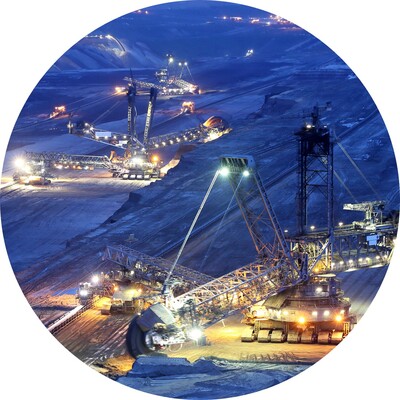Boyden Report Series
What’s Next for Industry? AI, Transformation, and the Talent Imperative
Industrial Trends Report: Analysing markets, studies, and trends on how AI, machine learning, and digitalisation are reshaping the industrial sector, with expert insights on talent and leadership from Boyden’s Global Industrial Practice Members.

Mining, Metals & Natural Resources
Digital Digs: AI and the New Age of Resource Extraction
- The mining industry faces a multitude of challenges: from soaring demand for minerals that underpin energy transition, notably copper, cobalt and lithium; through declining productivity and profitability; to balancing resource extraction and negative impacts to achieve net zero.
- In the face of this, AI has the potential to transform the mining and metals industry by increasing efficiency, reducing costs and improving safety and environmental sustainability.
- It's an energising time for the industry, as AI continues to evolve and be adopted more widely:
-
- In exploration, technological advancements have enabled more efficient and accurate exploration methods, improving the success rate of finding new mineral deposits; and
- In production processes, technological advancements, including automation and robotics, have improved efficiency, safety and environmental impact.
- AI applications in current use of development can support:
-
- Resource Exploration: AI driven models and machine learning algorithms can analyse geological and geophysical data to identify potential mineral deposits more accurately and efficiently than traditional methods
- Mining set up: AI can identify the optimal mining approach (open pit vs. underground), based on geological, economic and regulatory factors
- Operational Efficiency: AI algorithms optimise mining operations by analysing real-time data to improve productivity and reduce energy consumption. This includes better drilling and blasting patterns, as well as managing logistics and supply chains
- Safety Enhancements: AI enhances safety by monitoring environmental conditions and worker behaviour. It can detect hazardous situations and alert operators to potential dangers, reducing the risk of accidents
- Predictive Maintenance: AI-powered systems can predict equipment failures before they happen by analysing data from sensors and historical maintenance records. This reduces downtime and maintenance costs
- Autonomous Vehicles: Autonomous trucks, drills, and other mining equipment can operate continuously without human intervention, increasing efficiency and reducing labour costs
- Environmental Monitoring: AI systems can monitor environmental conditions, such as air and water quality, to ensure compliance with regulations and minimise environmental impact. Environmental impact can be optimised through integrated geologic and hydrologic data
- Supply Chain Management: AI helps in predicting supply chain disruptions and optimizing inventory management, ensuring a steady supply of materials and reducing costs
- Data Analysis: AI can collate and process vast amounts of data from different sources, providing insights that help in decision-making and strategic planning
- Mine closure: AI can help reduce the environmental impact of post-mining reclamation and abandonment
- Integrated economic, social and environmental goals: a holistic approach to AI could ensure multi-objective optimisation across these three areas, to align with UN Sustainable Development Goals (SDGs)
- From a global perspective, it is important to recognise ethical concerns in the use of AI relating to data bias, transparency and alignment with cultural and regional needs; most frameworks are currently being developed by Global North nations for Global South application. For example, AI systems trained on data from Canada may perform better there than in Zambia, widening socio-economic gaps. Differences in technical approach, equipment, terrain, organisational size and capabilities need to be factored into AI design and deployment.
- Operational AI tools are a significant advantage for safety, with robots and sensors reducing workers’ exposure to hazardous conditions, from earthquakes, earth slides, toxic gases, radiation and dust to inadequate lighting.
- In keeping with other industrial sectors, AI provides significant advantages in predicting maintenance requirements, water management, optimising waste management and identifying pollution violations.
- While AI promises increased efficiency, productivity, profitability and safety, environmentalists point to the ‘Jevons paradox1’ whereby increased mining efficiency may inadvertently encourage over-extraction and delay transitions to sustainable energy. Advocates for greater awareness highlight a need to address the complex dynamics between efficiency and consumption to navigate potential longer-term challenges of resource depletion and climate change.
"In addition to the challenge of developing and adopting new technologies, the mining industry is currently grappling with significant talent shortages, with +70% of mining leaders highlighting this issue as a barrier to meeting production targets. The industry's reliance on outdated practices and technologies increases this challenge. To attract and retain talent, mining companies must prioritize digital transformation and embrace cutting-edge technologies that enhance efficiency and sustainability. The younger generation is drawn to innovative and tech-driven workplaces, so modernizing operations through advanced digital solutions is crucial for securing the future workforce."
Euri Cruz
Managing Partner, Brazil
Global Sector Leader, Mining & Primary Materials

From Miners to Data-Driven Decision Makers: AI’s Influence on Leadership
- Attracting talent, both in leadership and in the workforce, has historically required a keen focus in the mining industry. For AI to deliver on broad expectations across the industry, organisations need strong data foundations and AI-savvy leadership.
- As the bedrock of tomorrow’s global economy, providing the minerals, commodities and metals on which multiple industries depend, there is a huge need to reposition the mining industry and opportunities within it to attract the best scientific management and leadership talent; in particular, its crucial role in the green economy, so important to next gen talent.
- All industries are now competing for the best tech talent, specifically AI experts in every area and at every level of the organisation. Today’s environment requires a ‘digital twin’ of yesterday’s traditional worker: data scientists, software architects and machine learning engineers working with today’s innovation-driven managers and C-suite leaders.
- The challenges that AI-based advancements bring are numerous, requiring broad leadership understanding and foresight around cybersecurity concerns, data management and multi-objective integration.
- The need for highly skilled people requires savvy analysis to define the scope of fast-evolving roles and how they fit together across an entire, AI-led industry, from geoscientists to site managers, functional leaders to board directors.
- Not only that, but next gen mining executives already have different profiles, come from different talent pools and engage with each other in a myriad of ways.
- The good news is that transferable skills exist across the entire industrial spectrum; the challenge is to assess transferability as a two-way street for the individual, the teams in which they will work and the organisation itself. Which means mining organisations must continue to evolve their culture, employee brand, business models, partnerships and approach to skills and leadership development.
Read more on the topic:
- Microsoft: Future-proof the mining industry with AI and digital innovation
- Science Direct: A review of the use of AI in the mining industry
- BHP: AI is unearthing a smarter future
- Appian Advisory: Solving the talent challenge in mining requires doing mining the right way
[1] William Stanley Jevons was a British economist who first described this paradox in his 1865 book ‘The Coal Question’.




